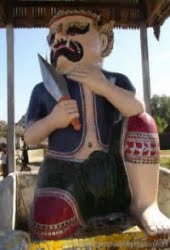The pagoda is located on the steep mountain which is in the left river bank of Thandwe river and one mile fur from Thandwe. This pagoda is also a prophetic pagoda of Buddha. Buddha prophesied Anan Da, “Dear Anan Da, the pagoda called Sandaw will be built enshrining my hair relic after I had gained Parinibbanna as I had ever been a king of the bird of paradise in Manikaytha mountain in a previous life of mine.”
The governor Min Nyo Khin of the city of Dawrawaddy built the pagoda in AD 784 according to Buddha’s prophecy. Rakhine successive kings such as king Maha Soe, king Ra Zar Gyi and king San Da Thu Dham Ma renovated it. The residents of Thandwe renovated it again in 1849 AD and 1876 AD respectively. The form of the pagoda is octagonal in shape. It measures 65 feet in height and 180 feet in circumference at the base. The upper part of the bell-shaped dome, is conical and there are no decorations, caves and porches. The pagoda court is enclosed with the octagonal-shaped wall. There are three entrances around the wall, but only one entrance has the brick stairway. The brick stairway provides an access to the pagoda from the base of the mountain. It has 204 steps and the balustrade of the stairway is 3 feet high. The small bell is in the north-east of the pagoda. The contemporary religious buildings are occupying the base of the mountain. Among them, the distinctive building is the building in the form of the cave cemetery of the Mohanmedan. The inner room is square, and the roof and the ceiling are spherical.
Reference
1. Rakhine Touristy Stupas, 2008 by Htay Win













0 comments